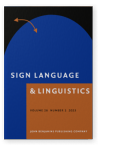Vol. 26:2 (2023) ► pp.176–217
Strategies for new word formation in NGT
A case for simultaneous morphology
How do new words arise in a sign language? We present an empirical study of newly formed words in Sign Language of the Netherlands (NGT). Five signers were asked to create new forms for known concepts for which word forms exist in NGT. Participants used sequential strategies for word formation, also found in spoken languages. More frequently, however, they used simultaneous strategies, some of which are unique for the visual-manual modality. We describe and discuss each strategy and focus on the most prominent of these, namely the simultaneous combination of meaningful form elements (Form-Meaning Units or FMUs). The abundance of simultaneous combinations of FMUs in our data cannot be explained in terms of concatenative morphology. We propose an account for word formation phenomena in NGT that uses the phonological segment as the template for simultaneous combinations of FMUs. This study shows that the FMUs function as basic building blocks for words and accordingly can be considered morphemes. Given the large set of FMUs in NGT and their frequent occurrence in the newly formed lexical words in our data, we argue for the acknowledgement of more morphological complexity within the lexicon of sign languages and for a re-evaluation of the relation between sign language phonology, morphology, and syntax.
Article outline
- 1.Introduction
- 2.Background
- 2.1Terminology
- 2.2Word formation strategies in sign languages
- 2.2.1Compounding
- 2.2.2Derivation
- 2.2.3Loan translation
- 2.2.4Classifier constructions
- 2.2.5Other sources of lexicon expansion in sign languages
- 2.3The Dependency Model
- 2.4The present study
- 3.Methodology
- 3.1Materials
- 3.2Participants and procedure
- 3.3Analysis
- 4.Results
- 4.1Strategies
- 4.2.1Combinations of existing words: Compounds and blends
- 4.2.2FMU combinations
- 4.2.3Combination of existing signs with one or more FMUs
- 4.2.4Semantic extension
- 4.2Distribution of the strategies
- 4.1Strategies
- 5.Discussion
- 6.Summary and conclusions
- Acknowledgements
- Notes
-
References
